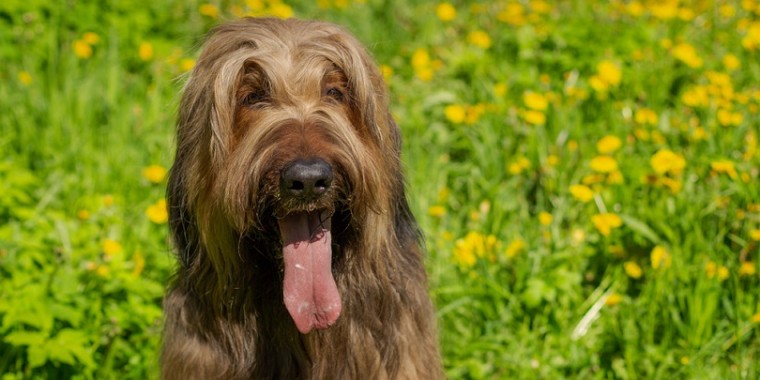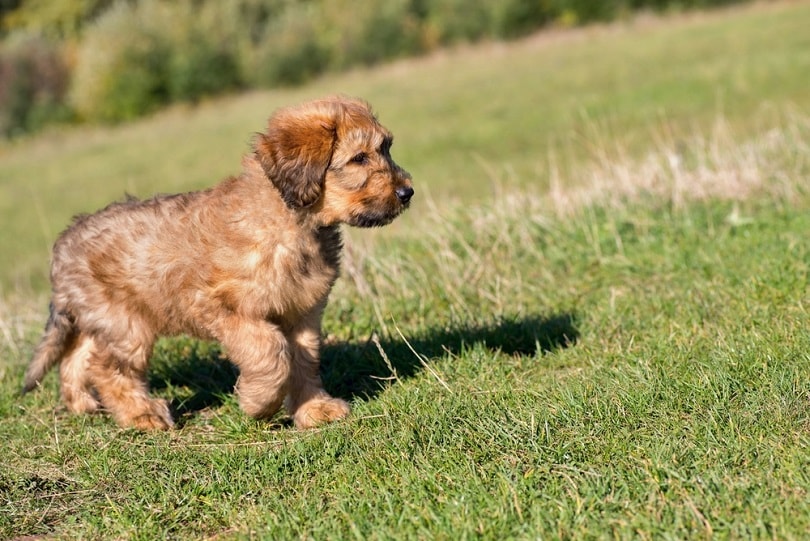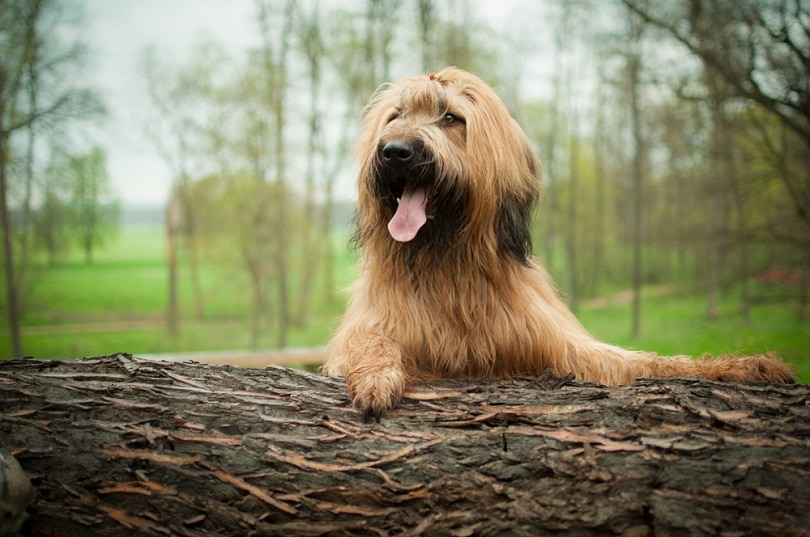
Click Below to Skip Ahead
If you are looking for a dog that just so happens to be named after a very fancy cheese, then look no further than the Briard. Yes, they were in fact named after brie cheese. These lovable giants hail from France and were bred to do one thing—protect the pastures of sheep that roam the French farmlands.
While they are named after the gooey cheese, these dogs are anything but soft. More than capable of running off predators or anything you don’t want around, Briards are fearless guard dogs.
Breed Overview
Height:
22 – 26 inches (female), 23 – 27 inches (male)
Weight:
50 – 75 pounds (female), 60 – 90 pounds (male)
Lifespan:
10 – 12 years
Colors:
Black, white, tawny, grey, black & tawny, black & grey
Suitable for:
Active families, those with big yards, wanting a guard dog
Temperament:
Fearless, obedient, protective, Loyal, Intelligent
While we love this breed, they simply aren’t for everyone. They make great companions, but they aren’t likely to want to snuggle up and do nothing all day. Maybe, after hard days’ work, they may be ready to snuggle up and watch some Netflix (only if you have great taste in movies) and they make great family pets. But before you go off and find a Briard breeder, there are some things you need to know.
Let’s look at why this dog could be your perfect match or why you need to swipe away from them.
Briard Characteristics
Briard Puppies

There is no denying that the Briard makes a fantastic family dog. However, before you think about getting one for you and your family, the main thing to know is the Briard is a working dog. They are happiest when they have a job to do. Oh, they love being pampered, but only after they have put in a hard day’s work.
If your family loves to have movie days and chill daily, then this pup isn’t going to suit your family. Wile you don’t need a ranch to work this breed, you need a lot of exercise and places to run around. Apartment life is not for this dog at all. When a Briard is bored, your house becomes a giant chew toy, and no one wants that.
Briards are herding and guard dogs. They take both tasks very seriously. Strangers are going to be a touchy subject with this dog, even if you aren’t in danger. They can be a handful to those who aren’t looking for a protector or watchdog. This also means that meek or mild dog parents need not apply for the Briard. They need an experienced owner or they will walk all over you.

Temperament & Intelligence of the Briards
While yes, this breed isn’t for everyone, the Briard makes a wonderful family pet for many people. They are super loving and affectionate around those they consider part of the family. If you can keep them busy and entertained during the day, then at night they are ready to hang with you. They want to be part of the human group and want to be involved in all activities.
Plus, if you’ve ever wondered what it was like to have two shadows, then this is your dog. It isn’t so much they are needy; they just want to make sure you are safe at all times. Not every pet parent is thrilled to have a dog like this, but if you don’t mind, then this could be the dog for you.
This breed is very intelligent. They love to play games with their family, including hide-and-seek. This is a fun and great trait for a dog but… They are independent dogs who will do what they want if they feel like it. That is why training is critical. They may not always listen to what you are saying, but they try to listen.
Are These Dogs Good for Families? 👪
Honestly, this really depends on your family. If you have an active family that is always up and moving then yes, this could be a match made in heaven. Do you love jogging, hiking, swimming, or even just playing lots of games in the backyard? Then yes, this dog could easily be the dog for you.
The more active lifestyle you have with your busy family, the better. However, you have to include your pooch in the busy life. You simply can’t leave this breed behind if you are off traveling. They need your attention and fun times.
What you will need to watch out for is the herding behavior. You may notice that they want to keep the younger family members in one spot. While tempting to allow it to happen, it shouldn’t be tolerated as that can get them in trouble.
Does This Breed Get Along with Other Pets?
Yes, but only if they have been socialized well. This breed needs to be socialized from a puppy on to become a polite adult. If you want to own a Briard and you have other pets, then you need to introduce them slowly. Make sure they understand that these are their pet siblings.
Now, if you live on a ranch, you can expect they will want in on the action. They won’t be perfect at herding, but with some training they make a great friend. If you can get them involved, then they will be happy animals.

Things to Know When Owning a Briard:
If your heart is set on getting a Briard, there are things you need to know about these dogs. Take note so you have everything your new family member needs to be the best they can be.
Food & Diet Requirements 🦴
Like many larger breeds with an energetic lifestyle, you need a high-quality dog food that isn’t full of fillers. This means look for food that has plenty of protein. There are plenty of commercial diets that have protein at the top of the list. Make sure you have a food that has as little mystery ingredients as possible.
Since they are larger dogs, they can eat up to 3 cups of food a day. While it may seem tempting to server them one big meal, that is highly discouraged. Spread their meals out during the day to prevent something known as gastric torsion or bloat.
During puppyhood they need a food full of calcium and phosphorus. This reduces the changes in developing bone diseases such as hip dysplasia.

Exercise 🐕
You’ve seen that the Briard is an energetic pup, but what does that mean? You need to set aside at least one hour of your day for exercise. An hour stroll won’t be enough. You need to take them out and really get that blood moving.
An hour jog or even playing fetch is a great way to get energy out. They also love to swim, so the local lake, beach, or doggy park is a great place to go. If you don’t wear this dog out, then you are going to have a dog that is ready to go as soon as you get home. A tired Briard is a happy Briard.
There also needs to be a mix of activities. You’ll want to change your routine and add in new activities to keep them stimulated. They need brain stimulation too, so training, games, or even puzzle toys are a great way to keep them busy.
Training 🎾
These dogs are intelligent enough to learn most commands. However, if you don’t start this early, then you are going to have a domineering dog on your hands. They need to be properly socialized in order to be on their best behavior.
To keep aggression down, you need to expose them to unfamiliar animals and people. They are so protective that they need to understand that strangers aren’t all bad. If you keep introducing them to the unfamiliar even as they get older, you’ll have a polite Briard that is alright with people.
The biggest issue you may run into is the herding issue. If you notice your Briard trying to herd your small animals or little ones, you need to stop it quickly. It isn’t really dangerous, but it can be a really unpleasant habit that leads to pet squabbles or children being knocked over. Many herding dogs also nip at the heels of animals, which the Briard does do. That can be scary for a little one to face.
Briards see themselves as one of the humans, and they don’t do well with being told off. Protective dogs need a firm leader that makes it known they are top dog. Positive reinforcement is a great way to make sure your dog understands you are the boss. Try not to yell at your Briard as they will sulk about it and ignore you.
Grooming ✂️
The Briard has lovely locks that can grow up to 6 inches long. They are going to need grooming every other day to keep the locks from getting matted. The brushing helps get rid of dead hair and dirt and spreads the natural coat oils out while keeping the fur tangle-free. Since the hair grows quickly, many owners take their Briard to a groomer to keep everything looking great.
Those lovely locks aren’t just for show, they are there to protect their skin from all kinds of weather. You won’t find the Briard wearing a raincoat.
They don’t shed too much, which is great for those with allergies to pet fur. In most cases, a good brushing is enough to keep the shed manageable. Briards should get a bath about every 8 to 12 weeks to make sure all the dirt and grim is out of the coat.
Nail trimming is a must in order to keep them from overgrowing and splitting. Since this breed has some eye concerns, make sure you monitor any changes. If you notice them blinking more or more mucus coming from the eye, then a trip to the vet is needed.
Health and Conditions 🏥
The Briard is generally a healthy dog. They are working dogs and the genes that would prevent that have been culled by now. Just like any dog though, they do have health concerns to look out for. Most happen in older age, just like in humans. Here are some of the health concerns to look out for in the Briard.
Male vs Female
This is one of the many breeds where the personality is based more on their upbringing, training, and the living environment, rather than the gender. When it comes down to gender, it is really a preference that you have rather than any difference.
The only difference you will notice is males are typically larger than females. Since they are already a large breed, the difference isn’t too much. To get an idea of how big your pooch will be, look at their parents. It is a great way to see how big they will get or could get.
3 Little-Known Facts About the Briard
1. They turned Thomas Jefferson into a dog lover.
One of America’s founding fathers was once a dog hater. However, he quickly learned to love the Briard when Lafayette sent some over to the newly formed United States to guard the livestock. Since they did such a good job, Jefferson learned to love these gentle giants.
2. Napoleon loved Briards.
Jefferson wasn’t the only one who turned into a dog lover when he met the Briard. Napoleon was also a man who had an aversion to dogs. However, he too learned to love this breed for its guardian style of love.
3. They are the French army’s official war dog.
Not only is the breed protective, but they are loyal dogs. The French army used them to track down wounded soldiers, pull heavy carts around, and work as guards during the first World War.
Final Thoughts
If you are going to be a Briard parent, then you are going to have a family dog that loves to be the center of attention. They are great guard dogs and can be a handful in the wrong type of family. If this breed speaks to you and you can tick all the boxes, then this is the dog for you.
If the Briard can change Napoleon’s mind, then you can be sure your family will adore this breed no matter what.
- You may also be interested in: Afaird (Afghan Hound & Briard Mix)
Featured Image Credit: Anastasia Badmaeva, Shutterstock









